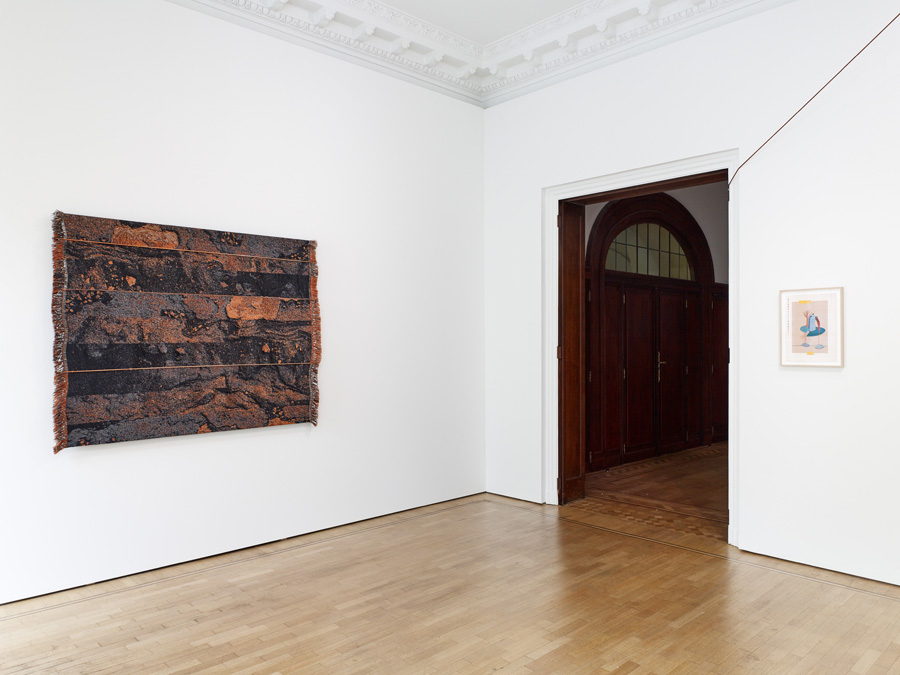Frieze
Transition — Otobong Nkanga, Mendes Wood DM, Brussels


I’m trying to think of an instrument more yielding than the needle. Is there another apparatus so charged with physical, economical and socio-political energy? A curved, stainless-steel rendering sits in the corridor of Mendes Wood DM. At 1.5-metres-long, it is part-suspended by a bi-toned, hand-dyed cotton rope that loops through its eye and soars to the ceiling of the space. The rust-coloured thread trails overhead throughout two rooms of the exhibition space, eventually bunching up in a pile on the floor. The work, Otobong Nkanga’s Coup d’état (2003/18) – installed at the entrance of the artist’s inaugural exhibition at the Brussels gallery – delivers a pointed message almost instantly: if ever you want to demonstrate the significance of a historically underpraised object, monumentalize it.
Titled ‘Transition’, Nkanga’s is a show about transformation, systems of change and improving our material condition within a fractured landscape. It ushers science and intuition into the same shared space and sets the two in conversation with one another. But there’s poetry here, too: an allegory within the needle’s ability to both sever and connect. The Antwerp-based Nigerian artist’s interest in the propinquity between violence and healing began in 2003, when she produced work in response to the ‘surgical hits’ that were orchestrated during the Iraq invasion. The co-opting and perverting of medical language to symbolise the encouragement of death, rather than its prevention, is likely the show’s darkest source of inspiration, but Donald Trump’s rise to power crawls out from a tenebrous hole of its own. In the woven textile work, Steel to Rust – Calibration (2018), Nkanga looks at how the US president’s appointment begot a course of social and industrial corrosion. Locked in place by two pure copper rods, the blended textile – comprising merino wool, viscose fabric and reflective yarn, amongst other threads – resembles a slab of marble, the effect of orange-red-brown oxidation effortlessly glowing from its smoky black background.
What Nkanga appears to be interrogating is our readiness to handle earth’s vulnerabilities with great insensitivity – an attitude which has tangible and emotional repercussions for the human body. Exploitative extraction processes have impacted the landscape of the artist’s West-African home country, and her preoccupation with the politics of Nigeria’s postcolonial economy and ecological state is as much about extricating the truth as it is about mounting her own conscience. Reconciliation (2018) forms part of a series of paintings on paper and depicts an incomplete mutant figure, alongside fractured bits of earth. In Masterplan (2018), a severed hand places a piece of fecund land into the ground, the ‘masterplan’ in question being an attempt to rectify our past environmental wrongdoings. The voice that speaks from this work is maternal; its definite tone feels gentle, encouraging even. Another layer down, feelings of displacement and belonging stretch far and wide, but remain under control – see the subdued pinks, thriving greens, steady lines. Nkanga paints the complexity of her existential woes with stoical pacing. The works aren’t the most technically gripping, but where refinement is absent, altruism appears in abundance.
But the dismembered body parts in Nkanga’s paintings aren’t universal representations of all bodies. They belong to a black woman, a person whose wellbeing is the most stunted by our current viscous climate. Beyond environmentalism, there are a legion of reasons why the planet can be(come) uninhabitable for them, for us, and perhaps Nkanga’s practice is endeavouring to establish new structures and grounds for germination, where Quality of Life (QOL) can flourish for black women and their friends, in that specific order.